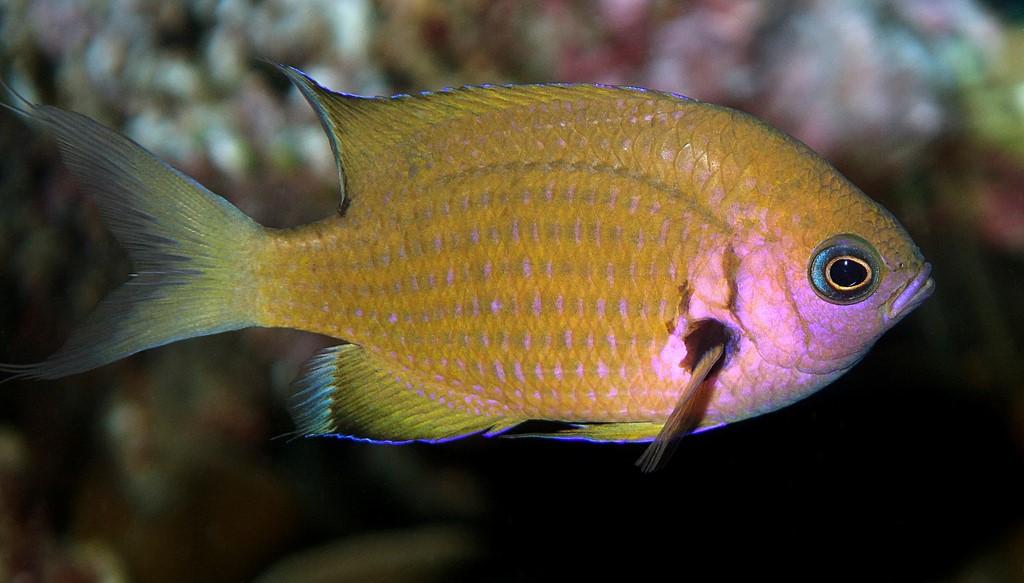PYCNOCHROMIS PACIFICA - (ALLEN & ERDMANN, 2020)
Picture courtesy of: Alain Daoulas
Chromis du Pacifique bronze, Pacific bronze chromis,
Synonyme
Chromis pacifica (Allen & Erdmann, 2020)
---------------------------
Description
Dorsal spines (total): 12-13; Dorsal soft rays (total): 12-14; Anal spines: 2; Anal soft rays: 12-14; All dorsal-fin and anal-fin soft rays branched, last to base; Pectoral fin rays: 16-18, uppermost and lowermost two unbranched; Pelvic fin rays: I, 5; Principal caudal fin rays: 15, uppermost and lowermost unbranched; Spiniform caudal fin rays: 2, followed by two accessory segmented rays; Scales in longitudinal series: 27; Tubed lateral line scales: 14-17 (usually: 15); Posterior midlateral scales with a pore or deep pit (in continuous series): 7/8 (5-9, usually: 7-8); Scales above lateral line to origin of dorsal fin: 2.5; Scales above lateral line to base of middle dorsal fin spine: 1.5; Scales below lateral line to origin of anal fin: 8.5; Gill rakers: 8 + 21 = 29 (7-9 + 19-24), total: 27-32); Branchiostegal rays: 6; Supraneural (predorsal) bones: 3; Vertebrae: 11 + 15. Body relatively deep and ovate, depth: 1.9 (1.8-2.0) in SL, and compressed, body width: 2.9 (2.7-3.1) in body depth; Head length: 3.5 (3.1-3.6) in SL; Dorsal profile of head with slight convexity above eye; Snout shorter than orbit diameter, length: 3.5 (3.3-4.7) in HL; Orbit diameter: 3.1 (2.3-2.9) in HL; Interorbital space convex, width: 3.0 (2.7-3.1) in HL; Caudal peduncle depth: 1.8 (1.7-2.1) in HL; Caudal peduncle length 1.8 (1.8-2.5) in HL. Mouth terminal, small, and oblique, forming an angle of about 35° to horizontal axis of head and body; Posterior edge of maxilla reaching a vertical about level with anterior edge of pupil, upper-jaw length: 3.0 (2.9-3.5) in HL. Max. length: 8.0 cm SL. Depth range: 5 - 56 m.
Color
Adults overall yellowish brown, typically with lateral greyish to purplish stripes, following scale rows; Suborbital, cheek, opercle, and breast with lavender hue of variable intensity; Upper rear edge of opercle with diffuse brown outline; Iris bluish with narrow yellow ring around margin of pupil; Dorsal, anal, and pelvic fins with narrow blue outer margin; Dorsal and anal fins brownish with dark-brown triangular marking posteriorly, both fins abruptly translucent posterior to marking, a conspicuous dark brown spot at base of last two dorsal-fin rays; Pectoral fin with prominent round blackish spot covering entire base and axil of fin; Pelvic fins dusky yellowish; Caudal fin yellowish. Large juveniles and subadults similar except upper lip violet to lavender and often longitudinal rows of lavender spots, one per scale. Small juveniles largely bluish on upper half of body, including spinous dorsal fin; Blue color also prominent on lips, dorsal scleral surface of eye, and on pelvic fins; Caudal fin yellow.
Etymology
Pycnochromis: from ancient Greek, puknós = dense, compact, thick. Referring to “very smooth” head of Pycnochromis vanderbilti, the “edges of the suborbitals, preopercle and opercle little distinct” + from chromis: from Greek, chroemo = to neigh. A name dating to Aristotle, referring to a drum (Sciaenidae) and its ability to make noise; Later applied to this damselfish and subsequently expanded to embrace dottybacks, cichlids and wrasses (all perch-like fishes once thought to be related).
pacifica: named for its native range in the Pacific Ocean.
Orginal description: Chromis pacifica Allen & Erdmann, 2020 - Locality type: Holmes Reefs, Coral Sea, Australia, -16.4499°, 148.0014°, depth 5 - 8 meters, barrier net, T. Bennett, 20 March 2017.
Distribution
Western and central Pacific: Hawaiian Islands, Johnston Atoll, Line Islands, Pitcairn Island, Oeno Atoll, Gambier Islands, Tuamotu Archipelago, Society Islands, Austral Islands, Rapa, Cook Islands, Phoenix Islands, Fiji, Tonga, New Caledonia, Loyalty Islands, Chesterfield Islands, Vanuatu, Coral Sea islands and reefs, Marshall Islands, Chuuk, Pohnpei, Yap, Wake Island, Mariana Islands and north to Ogasawara and Bonin Islands (Japan).
Biology
Adults occur in clear lagoon and seaward reefs, usually in loose aggregations near caves and ledges. Abundant over branching corals and leeward coasts. Benthopelagic. Feeds on planktons. Oviparous, distinct pairing during breeding. Eggs are demersal and adhere to the substrate. Males guard and aerate the eggs.
Similar species
Pycnochromis agilis (Smith, 1960) - Reported from Western and central Indian Ocean: East Africa, Mozambique Channel, Comoros and Madagascar, Aldabra (Seychelles) and western Mascarenes (La Réunion) east to Maldives and Chagos Archipelago. Pycnochromis pacifica is distinguished from Indian Ocean, Pycnochromis agilis, by having a larger black spot at the base of the pectoral fin, covering the entire pectoral-fin base, inner and outer, vs. a smaller, less conspicuous spot mainly concentrated in the axil of the fin rather than the outer base. It also typically has multiple lateral greyish to purplish stripes on the body following scale rows (vs. none), and is generally darker brown.
Last update: 31, March 2024
